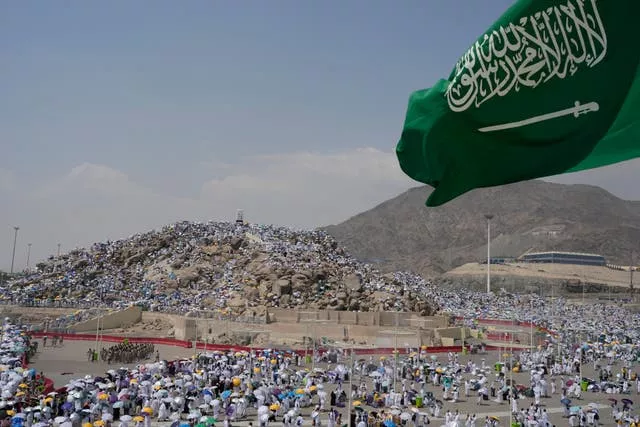Hordes of pilgrims embarked on a symbolic stoning of the Devil in Saudi Arabia on Sunday, the ritual marking the final days of the Hajj, or Islamic pilgrimage, and the start of the Eid al-Adha celebrations for Muslims around the world.
The stoning is among the final rites of the Hajj, which is one of the Five Pillars of Islam.
It came a day after more than 1.8 million pilgrims congregated at a sacred hill, known as Mount Ararat, outside the holy city of Mecca, which Muslim pilgrims visit to perform the annual five-day rituals of Hajj.
Fourteen Jordanian pilgrims have died from sunstroke during the Hajj pilgrimage, according to Jordan’s state-run Petra news agency.

The Foreign Ministry said in a statement that it has co-ordinated with Saudi authorities to bury the dead in Saudi Arabia, or transfer them to Jordan.
The pilgrims left Mount Arafat on Saturday evening to spend the night at a nearby site known as Muzdalifa, where they collected pebbles to use in the symbolic stoning of pillars representing the Devil.
The pillars are in another sacred place in Mecca, called Mina, where Muslims believe Ibrahim’s faith was tested when God commanded him to sacrifice his only son Ismail. Ibrahim was prepared to submit to the command, but then God stayed his hand, sparing his son.
In the Christian and Jewish versions of the story, Abraham is ordered to kill his other son, Isaac.

On Sunday morning, crowds headed on foot to the stoning areas.
Some were seen pushing disabled pilgrims in wheelchairs towards the complex housing the large pillars. Many pilgrims carried umbrellas to protect them against the burning summer sun.
An Associated Press reporter saw many pilgrims, especially the elderly, collapsing on the road to the pillars because of the burning heat.
As the temperature spiked by midday, more people required medical help. The heat had reached to 47C in Mecca and 46 C in Mina, according to Saudi meteorological authorities.

Security forces and medics were deployed to help, using trolleys to carry those who fainted to ambulances or field hospitals.
Many pilgrims will spend up to three days in Mina, each casting seven pebbles at three pillars in a ritual to symbolise the casting away of evil and sin.
While in Mina, they will visit Mecca to perform their “tawaf”, or circumambulation, which is circling the Kaaba in the Grand Mosque anti-clockwise seven times. Then another circumambulation, the Farewell Tawaf, will mark the end of Hajj as pilgrims prepare to leave the holy city.
The rites coincide with the four-day Eid al-Adha, which means “Feast of Sacrifice”, when better-off Muslims commentate Ibrahim’s test of faith by slaughtering livestock and animals and distributing the meat to the poor.
Most countries marked Eid al-Adha on Sunday; others, like Indonesia, will celebrate it on Monday.
Once the Hajj is over, men are expected to shave their heads and remove the shroud-like white garments worn during the pilgrimage, and women to snip a lock of hair in a sign of renewal and rebirth.
Most of the pilgrims then leave Mecca for the city of Medina, about 210 miles (340km) away, to pray in Prophet Muhammad’s tomb, the Sacred Chamber.
The tomb is part of the prophet’s mosque, one of the three holiest sites in Islam, along with the Grand Mosque in Mecca and the Al Aqsa Mosque in Jerusalem.
All Muslims are required to make the Hajj once in their lives if they are physically and financially able to do so. Many wealthy Muslims make the pilgrimage more than once.
The rituals largely commemorate the accounts of Prophet Ibrahim and his son Prophet Ismail, Ismail’s mother Hajar and Prophet Muhammad, according to the Koran, Islam’s holy book.
More than 1.83 million Muslims performed Hajj in 2024, Saudi Hajj and Umrah Minister Tawfiq bin Fawzan al-Rabiah said in a briefing, slightly less than last year’s figures when 1.84 million made the rituals.
Most of the Hajj rituals are held outdoors with little if any shade. It is set for the second week of Dhu al-Hijjah, the last month in the Islamic lunar calendar, so its time of the year varies. And this year the pilgrimage fell in the burning summer of Saudi Arabia. The heat soared to 47 degrees at Mount Arafat on Saturday.
This year’s Hajj came against the backdrop of the devastating Israel-Hamas war, which has pushed the Middle East to the brink of a regional conflict.
Palestinians in the Gaza Strip were not able to travel to Mecca for Hajj this year because of the closure of the Rafah crossing in May when Israel extended its ground offensive to the city on the border with Egypt. And they will not be able to celebrate the Eid al-Adha as they used to do in previous years.
Dozens of Palestinians gathered near a destroyed mosque in Gaza’s southern city of Khan Younis on Sunday morning to perform the Eid prayers. They were surrounded by debris and rubble of collapsed houses.
In the nearby town of Deir al-Balah in central Gaza, Muslims held their prayers in a school-turned-shelter. Some, including women and children, went to cemeteries to visit the graves of loved ones.
“Today, after the ninth month, more than 37,000 martyrs, more than 87,000 wounded, and hundreds of thousands of homes were destroyed,” Abdulhalim Abu Samra, a displaced Palestinian, told the AP after prayers in Khan Younis. “Our people live in difficult circumstances.”
There is also a conflict between rival generals in Sudan that has raged unabated for 14 months. It has killed thousands and created the world’s largest displacement crisis, with more than 10 million forced to flee their homes.







